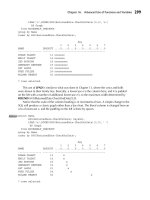scala how to make best use of functions and objects
Bạn đang xem bản rút gọn của tài liệu. Xem và tải ngay bản đầy đủ của tài liệu tại đây (773.69 KB, 60 trang )
Scala: How to make best use of
functions and objects
Phillip Haller
Lukas Rytz
Martin Odersky
EPFL
ACM Symposium on Applied Computing Tutorial
2
Where it comes from
Scala has established itself as one of the main
alternative languages on the JVM.
Prehistory:
1996 – 1997: Pizza
1998 – 2000: GJ, Java generics, javac
( “make Java better” )
Timeline:
2003 – 2006: The Scala “Experiment”
2006 – 2009: An industrial strength programming language
( “make a better Java” )
3
4
Why Scala?
5
Scala is a Unifier
Agile, with lightweight syntax
Object-Oriented Scala Functional
Safe and performant, with strong static tpying
6
What others say:
7
“If I were to pick a language to use today other than
Java, it would be Scala.”
- James Gosling, creator of Java
“Scala, it must be stated, is the current heir
apparent to the Java throne. No other language on the
JVM seems as capable of being a "replacement for Java"
as Scala, and the momentum behind Scala is now
unquestionable. While Scala is not a dynamic language,
it has many of the characteristics of popular dynamic
languages, through its rich and flexible type system,
its sparse and clean syntax, and its marriage of
functional and object paradigms.”
- Charles Nutter, creator of JRuby
“I can honestly say if someone had shown me the
Programming in Scala book by Martin Odersky, Lex Spoon &
Bill Venners back in 2003 I'd probably have never
created Groovy.”
- James Strachan, creator of Groovy.
8
Let’s see an example:
9
A class
public class Person {
public final String name;
public final int age;
Person(String name, int age) {
this.name = name;
this.age = age;
}
}
class Person(val name: String,
val age: Int) {}
in Java:
in Scala:
10
and its usage
import java.util.ArrayList;
Person[] people;
Person[] minors;
Person[] adults;
{ ArrayList<Person> minorsList = new ArrayList<Person>();
ArrayList<Person> adultsList = new ArrayList<Person>();
for (int i = 0; i < people.length; i++)
(people[i].age < 18 ? minorsList : adultsList)
.add(people[i]);
minors = minorsList.toArray(people);
adults = adultsList.toArray(people);
}
in Java:
in Scala:
val people: Array[Person]
val (minors, adults) = people partition (_.age < 18)
A simple pattern match
An infix method call
A function value
11
But there’s more to it
12
Embedding Domain-Specific Languages
Scala’s flexible syntax makes it
easy to define
high-level APIs &
embedded DSLs
Examples:
- Scala actors (the core of
Twitter’s message queues)
- specs, ScalaCheck
- ScalaFX
- ScalaQuery
scalac’s plugin architecture makes it easy to
typecheck DSLs and to enrich their semantics.
// asynchronous message send
actor ! message
// message receive
receive {
case msgpat
1
=> action
1
…
case msgpat
n
=> action
n
}
13
The Essence of Scala
The work on Scala was motivated by
two hypotheses:
Hypothesis 1: A general-purpose
language needs to be scalable; the
same concepts should describe small
as well as large parts.
Hypothesis 2: Scalability can be
achieved by unifying and generalizing
functional and object-oriented
programming concepts.
14
Why unify FP and OOP?
Both have complementary strengths for composition:
Object-oriented programming:
Makes it easy to adapt and extend
complex systems, using
•
subtyping and inheritance,
•
dynamic configurations,
•
classes as partial abstractions.
Functional programming:
Makes it easy to build interesting
things from simple parts, using
•
higher-order functions,
•
algebraic types and
pattern matching,
•
parametric polymorphism.
15
Scala
•
Scala is an object-oriented and
functional language which is
completely interoperable with
Java. (the .NET version is
currently under reconstruction.)
•
It removes some of the more arcane
constructs of these environments
and adds instead:
(1) a uniform object model,
(2) pattern matching and higher-
order functions,
(3) novel ways to abstract and
compose programs.
16
Scala is interoperable
Scala programs
interoperate seamlessly
with Java class libraries:
–
Method calls
–
Field accesses
–
Class inheritance
–
Interface implementation
all work as in Java.
Scala programs compile to
JVM bytecodes.
Scala’s syntax resembles
Java’s, but there are also
some differences.
object Example1 {
def main(args: Array[String]) {
val b = new StringBuilder()
for (i ← 0 until args.length) {
if (i > 0) b.append(" ")
b.append(args(i).toUpperCase)
}
Console.println(b.toString)
}
}
object instead of
static members
Array[String] instead of
String[]
Scala’s version of the
extended for loop
(use <- as an alias for ←)
Arrays are indexed
args(i) instead of args[i]
17
Scala is functional
The last program can also
be written in a
completely
different style:
–
Treat arrays as instances
of general sequence
abstractions.
–
Use higher-order
functions instead of
loops.
object Example2 {
def main(args: Array[String]) {
println(args
.map(_.toUpperCase)
.mkString(" ")
}
}
Arrays are instances of sequences
with map and mkString methods.
A closure which applies the
toUpperCase method to its
String argument
map is a method of Array which
applies the function on its right
to each array element.
mkString is a method of Array which
forms a string of all elements with a
given separator between them.
18
Scala is concise
Scala’s syntax is lightweight
and concise.
Contributors:
–
semicolon inference,
–
type inference,
–
lightweight classes,
–
extensible API’s,
–
closures as
control abstractions.
Average reduction in LOC wrt Java: ≥ 2
due to concise syntax and better abstraction capabilities
***** Guy Steele:
Scala led to a 4 times LOC reduction in the Fortress typechecker *****
var capital = Map( "US" → "Washington",
"France" → "paris",
"Japan" → "tokyo" )
capital += ( "Russia" → "Moskow" )
for ( (country, city) ← capital )
capital += ( country → city.capitalize )
assert ( capital("Japan") == "Tokyo" )
19
Scala is precise
All code on the previous slide
used library abstractions, not
special syntax.
Advantage: Libraries are
extensible and give fine-
grained control.
Elaborate static type system
catches many errors early.
import scala.collection.mutable._
val capital =
new HashMap[String, String]
with SynchronizedMap[String, String] {
override def default(key: String) =
"?"
}
capital += ( "US" → "Washington",
"France" → "Paris",
"Japan" → "Tokyo" )
assert( capital("Russia") == "?" )
Specify kind of collections: mutable
Specify map implementation:
HashMap Specify map type: String to
String
Mixin trait SynchronizedMap to
make capital map thread-safe
Provide a default value: "?"
20
Big or small?
Every language design
faces the tension whether
it should be big or
small:
–
Big is good: expressive,
easy to use.
–
Small is good: elegant,
easy to learn.
Can a language be both
big and small?
Scala’s approach:
concentrate on
abstraction and
composition capabilities
instead of basic language
constructs.
Scala adds Scala removes
+ a pure object
system
- static members
+ operator
overloading
- special treatment of
primitive types
+ closures as control
abstractions
- break, continue
+ mixin composition
with traits
- special treatment of
interfaces
+ abstract type
members
- wildcards
+ pattern matching
21
Scala is extensible
Guy Steele has
formulated a benchmark
for measuring language
extensibility [Growing a
Language, OOPSLA 98]:
Can you add a type of
complex numbers to
the library and make
it work as if it was
a native number type?
Similar problems: Adding
type BigInt, Decimal,
Intervals,
Polynomials
scala> import Complex._
import Complex._
scala> val x = 1 + 1 * i
x: Complex = 1.0+1.0*i
scala> val y = x * i
y: Complex = -1.0+1.0*i
scala> val z = y + 1
z: Complex = 0.0+1.0*i
22
Implementing complex numbers
object Complex {
val i = new Complex(0, 1)
implicit def double2complex(x: Double): Complex = new Complex(x, 0)
}
class Complex(val re: Double, val im: Double) {
def + (that: Complex): Complex = new Complex(this.re + that.re, this.im + that.im)
def - (that: Complex): Complex = new Complex(this.re - that.re, this.im - that.im)
def * (that: Complex): Complex = new Complex(this.re * that.re - this.im * that.im,
this.re * that.im + this.im * that.re)
def / (that: Complex): Complex = {
val denom = that.re * that.re + that.im * that.im
new Complex((this.re * that.re + this.im * that.im) / denom,
(this.im * that.re - this.re * that.im) / denom)
}
override def toString = re+(if (im < 0) "-"+(-im) else "+"+im)+"*I"
}
+ is an identifier; can be used as
a method name
Infix operations are method calls:
a + b is the same as a.+(b)
Objects replace static class members
Implicit conversions for mixed arithmetic
Class parameters instead of
fields+ explicit constructor
23
Implicits are Poor Man’s Type Classes
/** A “type class” */
class Ord[T] { def < (x: T, y: T): Boolean }
/** An “instance definition” */
implicit object intOrd extends Ord[Int] {
def < (x: Int, y: Int) = x < y
}
/** Another instance definition */
implicit def listOrd[T](implicit tOrd: Ord[T]) = new Ord {
def < (xs: List[T], ys: List[T]) = (xs, ys) match {
case (_, Nil) => false
case (Nil, _) => true
case (x :: xs, y :: ts) => x < y || x == y && xs < ys
}
}
24
The Bottom Line
When going from Java to Scala, expect at least a factor
of 2 reduction in LOC.
But does it matter?
Doesn’t Eclipse write these extra lines for me?
This does matter. Eye-tracking experiments* show that
for program comprehension, average time spent per word
of source code is constant.
So, roughly, half the code means half the time necessary
to understand it.
*G. Dubochet. Computer Code as a Medium for Human Communication: Are Programming Languages Improving?
In 21st Annual Psychology of Programming Interest Group Conference, pages 174-187, Limerick, Ireland, 2009.
25
Part 2: The Scala Design









